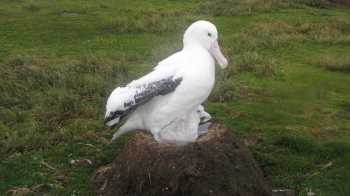Deborah Pardo (British Antarctic Survey) and colleagues have published in the journal Oecologia on senescence in Wandering Albatrosses Diomedea exulans.
The paper’s abstract follows:
“Sex differences in lifespan and aging are widespread among animals. Since investment in current reproduction can have consequences on other life-history traits, the sex with the highest cost of breeding is expected to suffer from an earlier and/or stronger senescence. This has been demonstrated in polygynous species that are highly dimorphic. However in monogamous species where parental investment is similar between sexes, sex-specific differences in aging patterns of life-history traits are expected to be attenuated. Here, we examined sex and age influences on demographic traits in a very long-lived and sexually dimorphic monogamous species, the wandering albatross (Diomedea exulans). We modelled within the same model framework sex-dependent variations in aging for an array of five life-history traits: adult survival, probability of returning to the breeding colony, probability of breeding and two measures of breeding success (hatching and fledging). We show that life-history traits presented contrasted aging patterns according to sex whereas traits were all similar at young ages. Both sexes exhibited actuarial and reproductive senescence, but, as the decrease in breeding success remained similar for males and females, the survival and breeding probabilities of males were significantly more affected than females. We discuss our results in the light of the costs associated to reproduction, age-related pairing and a biased operational sex-ratio in the population leading to a pool of non-breeders of potentially lower quality and therefore more subject to death or breeding abstention. For a monogamous species with similar parental roles, the patterns observed were surprising and when placed in a gradient of observed age/sex-related variations in life history traits, wandering albatrosses were intermediate between highly dimorphic polygynous and most monogamous species.”

A Wandering Albatross broods its chick. Photograph by John Cooper
Click here to access a similar paper by the same author.
Reference
Pardo, D., Barbraud, C. & Weimerskirch, H. 2013. Females better face senescence in the wandering albatross. Oecologia DOI 10.1007/s00442-013-2704-x.
John Cooper, ACAP Information Officer, 16 July 2003

 English
English  Français
Français  Español
Español